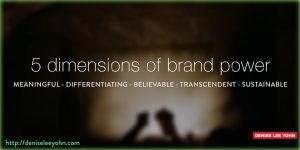A couple of weeks ago I started a blog post series on how to scale-up your brand. Today I’m going to discuss five critical dimensions of brand power. These dimensions indicate the strength of your brand to establish and maintain competitive advantage, command a price premium, and win customers’ loyalty. They provide a simple way to assess your brand power.
Refer to these five dimensions as you scale your organization. If you’re just starting out, use them to shape your brand vision. If you’re in the early stages of scaling, use them as a filter for decisions about what to do and what not to do. If you’re in the later stages, use them for periodic assessment and course correction.
Consider rating your brand on a scale of 1 to 5 for each of these dimensions and tracking if your ratings improve over time. Also ask key stakeholders — partners, employees, primary customers — to rate your brand and then work together to address differences in responses.
By no means are these the only dimensions of brand power, but in my experience, I’ve found that they are the most fundamental ones.
- meaningful — A meaningful brand is relevant and compelling to a valuable customer target(s). Let me break that down a bit:
- relevant — Your brand should connect to a customer need or want.
- compelling — Your brand should prompt action or reaction.
- valuable customer target — Your brand should appeal to customers who want to buy your product/service or add value to you in some other way.
- differentiating – A brand should be distinct from other options. And here’s the important part, it should be distinct in a way that customers perceive is important. Your brand differentiation can’t be negligible or simply a veneer.
- believable – Your brand should be grounded in the natural and inherent strengths of your product/service. I always say,
A brand can’t just be a promise; it must be a promise delivered.Click To Tweeta brand can’t just be a promise; it must be a promise delivered. A corollary is, if it sounds too good to be true, it probably is. Customers must believe that you can and will deliver on your brand promise — and sometimes you have to earn their permission to even make a claim.
- transcendent — A transcendent brand conveys value beyond a specific offering. This means it connects with customers at a higher level. In my book, What Great Brands Do, I write about how great brands avoid selling products. I explain that people are emotional creatures and we make purchase decisions based on our feelings. So your brand should satisfy customers’ emotional needs and/or offer access to an identity they want to experience and express.
- sustainable – A brand should be based on an enduring idea that enables your business to resonate and compete now and in the future. The appeal of a brand that is tied to a fad or fleeting trend is short-lived and entirely dependent upon circumstances outside your control. You should conceive of your brand to make both an immediate and a long-lasting impact.
I’m curious to hear which of these brand dimensions resonates with you the most — and which one(s) you think are the most difficult to achieve. Please leave your comments below.
In my next post, I’ll start introducing you to different tools and exercises you can use to develop or refine your strategic brand platform. Consider subscribing to my feed so you’ll be notified when the next in this Scale-Up Your Brand series is ready. (And here’s the link if you missed my first post, How to Conduct a Brand Diagnostic.)
The post scale-up your brand — assess your brand power appeared first on Denise Lee Yohn.











